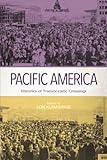Pacific America : Histories of Transoceanic Crossings / ed. by Lon Kurashige.
Material type: TextPublisher: Honolulu : University of Hawaii Press, [2017]Copyright date: ©2017Description: 1 online resource (288 p.) : 5 b&w illustrations, 1 mapContent type:
TextPublisher: Honolulu : University of Hawaii Press, [2017]Copyright date: ©2017Description: 1 online resource (288 p.) : 5 b&w illustrations, 1 mapContent type: - 9780824855765
- 9780824855796
- 305.8
- online - DeGruyter
- Issued also in print.
| Item type | Current library | Call number | URL | Status | Notes | Barcode | |
|---|---|---|---|---|---|---|---|
 eBook
eBook
|
Biblioteca "Angelicum" Pont. Univ. S.Tommaso d'Aquino Nuvola online | online - DeGruyter (Browse shelf(Opens below)) | Online access | Not for loan (Accesso limitato) | Accesso per gli utenti autorizzati / Access for authorized users | (dgr)9780824855796 |
Frontmatter -- CONTENTS -- Preface -- Introduction: Integrating the Pacific -- Part I. China and Ocean Worlds -- 1. A Very Long Early Modern? Asia and Its Oceans, 1000-1850 -- 2. Transatlantic and Transpacific Connections in Early American History -- Part II. Circuits and Diaspora -- 3. The Pacific Ocean as Highway to Gold Mountain: The Hong Kong Connection, 1850-1900 -- 4. Pop Gingle's Cold War -- 5. Chinese and American Collaborations through Educational Exchange during the Era of Exclusion, 1872-1955 -- 6. Japanese Reinvention of Self through Hawai'i's Japanese Americans -- 7. Fighting the Postwar in Little Saigon -- Part III. Racism and Imperialism -- 8. Transpacific Accommodation and the Defense of Asian Immigrants -- 9. Kilsoo Haan, American Intelligence, and the Anticipated Japanese Invasion of California, 1931-1943 -- 10. Transpacific Adoption: The Korean War, US Missionaries, and Cold War Liberalism -- 11. Inter-Imperial Relations, the Pacific, and Asian American History -- 12. Japanese Immigrant Settler Colonialism and the Construction of a US National Security Regime against the Transborder "Yellow Peril" -- Part IV. Islands and the Pacific Rim -- 13. How the Portuguese Became White: The Racial Politics of Pre-Annexation Hawai'i -- 14. Who Closed the Sea? Archipelagoes of Amnesia between the United States and Japan -- 15. Japanese Commemorations of World War II in the Mariana Islands -- Contributors -- Index
restricted access online access with authorization star
http://purl.org/coar/access_right/c_16ec
In recent times, the Asia-Pacific region has far surpassed Europe in terms of reciprocal trade with the United States, and since the 1980s immigrants from Asia entering the United States have exceeded their counterparts from Europe, reversing a longstanding historical trend and making Asian Americans the country's fastest growing racial group. What does transpacific history look like if the arc of the story is extended to the present? The essays in this volume offer answers to this question challenging current assumptions about transpacific relations. Many of these assumptions are expressed through fear: that the ascendance of China threatens a U.S.-led world system and undermines domestic economies; that immigrants subvert national unity; and that globalization, for all its transcending of international, cultural, and racial differences, generates its own forms of prejudice and social divisions that reproduce global and national inequalities. The contributors make clear that these fears associated with, and induced by, pacific integration are not new. Rather, they are the most recent manifestation of international, racial, and cultural conflicts that have driven transpacific relations in its premodern and especially modern iterations. Pacific America differs from other books that are beginning to flesh out the transnational history of the Pacific Ocean in that it is more self-consciously a people's history. While diplomatic and economic relations are addressed, the chapters are particularly concerned with histories from the "bottom up," including attention to social relations and processes, individual and group agency, racial and cultural perception, and collective memory. These perspectives are embodied in the four sections focusing on China and the early modern world, circuits of migration and trade, racism and imperialism, and the significance of Pacific islands. The last section on Pacific Islanders avoids a common failing in popular perception that focuses on both sides of the Pacific Ocean while overlooking the many islands in between. The chapters in this section take on one of the key challenges for transpacific history in connecting the migration and imperial histories of the United States, Japan, China, Korea, Vietnam, and other nations, with the history of Oceania.
Issued also in print.
Mode of access: Internet via World Wide Web.
In English.
Description based on online resource; title from PDF title page (publisher's Web site, viewed 02. Mrz 2022)


